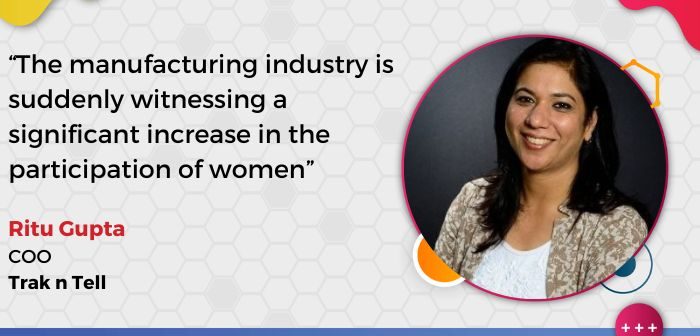By Ritu Gupta, COO, Trak n Tell
Traditionally dominated by men, the manufacturing industry is suddenly witnessing a significant increase in the participation of women. This reshapes workplace norms, drives economic growth, and fosters a more inclusive environment.
The changing demographics
Historically, manufacturing jobs in India have been perceived as labour-intensive and suited predominantly for men. However, recent trends indicate a substantial change. Women increasingly assume roles across various manufacturing units, challenging old stereotypes and contributing significantly to the sector.
According to a report by TeamLease, women now represent a growing percentage of the workforce in the manufacturing sector. This shift is reflected in the rise of women working in previously considered atypical roles, such as machinery operation and technical positions. The increasing presence of women is not just a statistic but a sign of a broader cultural shift towards gender inclusivity in the workplace.
Key drivers of change
Several factors are driving this change in the manufacturing sector:
- Policy support and incentives: Government policies and incentives aimed at promoting gender diversity are playing a crucial role. Initiatives like the “Stand Up India” scheme and various state-level programs provide financial and logistical support for women entrepreneurs and workers in manufacturing.
- Corporate initiatives: Many companies are implementing diversity and inclusion strategies to attract and retain female talent. Companies are setting up mentoring programs, offering flexible work hours, and providing family-friendly policies to support women in balancing work and personal life.
- Educational and skill development programs: As educational institutions and training programs increasingly focus on equipping women with technical skills relevant to manufacturing, the sector is seeing a rise in qualified female professionals. Programs designed to bridge the skill gap and promote STEM (Science, Technology, Engineering, and Mathematics) education among women are contributing to this positive trend.
Impact on the workforce and economy
The integration of women into the manufacturing workforce is having a profound impact on the industry. Diverse teams are known to foster innovation and improve problem-solving capabilities. Women bring different perspectives and approaches to manufacturing processes, which can lead to more efficient and creative solutions.
Furthermore, the economic benefits are substantial. According to a report by the National Association of Manufacturers (NAM), increasing the participation of women in manufacturing could significantly boost productivity and economic growth. Women in the workforce contribute to a more balanced economy and help address labour shortages in key sectors.
Challenges and roadblocks
Despite the positive trends, challenges remain. Women in manufacturing often face obstacles such as gender bias, lack of access to leadership roles, and inadequate support systems. Addressing these challenges requires a concerted effort from both the public and private sectors. Creating a supportive work environment, implementing gender-sensitive policies, and providing career advancement opportunities are crucial steps towards achieving true gender equality in manufacturing.
Success stories and future prospects
Several companies are leading by example and demonstrating the benefits of a diverse workforce. For instance, companies like Tata Steel and Larsen & Toubro have been recognised for their efforts in promoting gender diversity. These organisations have reported not only improved employee satisfaction but also enhanced overall performance.
Looking ahead, the future of women in manufacturing appears promising. As more women enter the field and break traditional barriers, the sector is likely to continue evolving towards greater inclusivity and innovation. Continued support from government policies, corporate strategies, and educational programs will be vital in sustaining this positive trend.
The rise of women in India’s manufacturing sector marks a significant milestone in the journey towards gender equality in the workplace. The shift is driven by a combination of policy support, corporate initiatives, and educational advancements. While challenges remain, the growing presence of women in manufacturing is set to drive economic growth, foster innovation, and contribute to a more inclusive and equitable industry.
References:
- Women’s Increasing Role in India’s Manufacturing Sector | TeamLease
- TeamLease: Women’s Increasing Role in India’s Manufacturing Sector
- Forbes: Women in Manufacturing – The Ball is Rolling, Now It Must Go Faster
- National Association of Manufacturers: More Women Join the Manufacturing Workforce
You might also want to read: India Needs a Robust AI Policy Framework
About Ritu Gupta
Ritu Gupta is the Co-Founder & COO, of Trak N Tell. Her responsibilities as COO are to manage HR, Administration, Finance. She also takes charge of managing the retail sales team and improving service networks.
Ritu is an LL.B. from CCS University, U.P. She last worked with Bank of America (USA) where she was responsible for managing her branch’s HNI clients. Her experience with customer delight has been instrumental in making Trak N Tell a customer-centric organisation.




